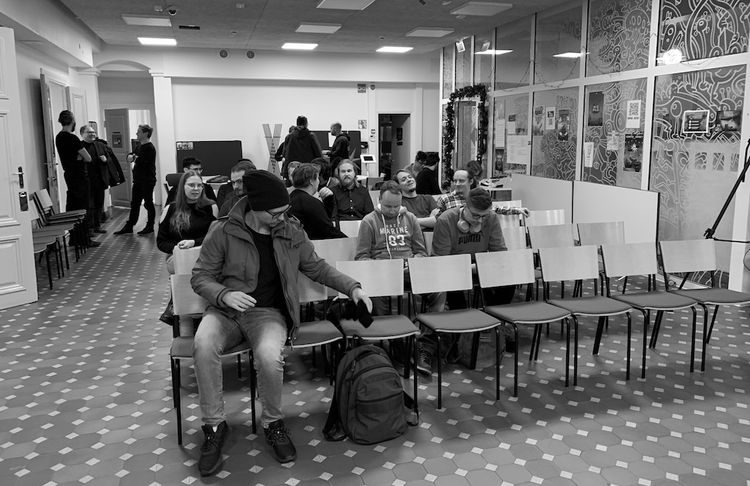How to structure a management team in gaming


I’ve been thinking about the ideal gaming company management. What kind of roles do you want at the top of the gaming company, next to the CEO?
I love flat organizations, but I think there are many pros in the hierarchical model that the flat model could learn from.
Foundation
First off, let’s look at the components in a gaming company organization that won’t budge. The ones that you will need, one way or another.
Mission and values: The foundation of any company is built on the following pillars: company mission and core values. The mission is what the company strives to achieve. It’s lasting, aspirational, and possibly unachievable, but it unites the company to work towards it. Core values are the behaviors that are aligned with the mission; they are the behaviors that guide the group towards the mission.
With a reliable company mission, if any discussion comes up, people should be able to ask, “Why does this allow us to achieve our mission?”
Company culture pyramid. A while ago, I wrote about the company culture that fits a gaming company. You can check out the pyramid by going here.
Communication: To work towards a mission, you want to have information and feedback flowing from the top to the bottom. It needs to be two-way, regular, and structured to favor a bottoms-up approach. Leaders are servants and facilitators of the company.

CEO: You will have a CEO, the personification of the company mission, the one who sets the pace, brings everybody together and is the external face of the company.
Investors and aboard: The model of venture-funded gaming studios is doing well in 2020 and most likely will be doing well for the perceived future. That’s why gaming companies will continue to have investors and board meetings. Out of the management team, the CEO and Chief Financial Officer, the CFO, will usually participate. This way, there are fewer people in the room, and the conversation flows much more smoothly.
Game teams. Over the years, it’s been proven that small game teams are the best unit to come up with a commercially-viable game. There are four or five people who share a common goal, concept, prototype, and build a game, that through validation and data, can be proved to be worth further investment. Until the game goes live, the team is kept as small as possible.
Other key people. Game publishing and live operations is a complicated endeavor, where more people are included in the mix. You get UA, community, support, data analyst, live ops specialists; you name it.
To start from the top, we want to look at the management team. Who is necessary, and what are the options to bring the best parts of a hierarchy into a flat organization?
Management teams in gaming

If you want to go on the flat side, here’s the thing. The whole idea of a flat hierarchy is that you don’t want leads, managers, and chiefs. You don’t want to have a management team bloated with all sorts of CTOs, CPOs, and CMOS.
From the observations of 15 years in gaming, I believe that the management could consist of two individuals, plus an extended management team, including the product owners from each game team.
Core management: Besides the CEO, I would want to see a double role taken by one individual, who would act as the COO & CFO, meaning the chief operations officer and the chief financial officer. They would serve as “the Chief of Staff” for the CEO, and they’d have a finance team and an HR/Ops team under their wing. The perfect real-life example of this is Supercell COO & CFO Janne Snellman. In the early days of a startup, the COO & CFO would focus on the chief of staff role. They would participate in board meetings, continuing these tasks as the company grew. They would eventually build teams that would report to the COO & CFO.
Granted, the COO & CFO does sound like good old hierarchical leadership, but it brings lots of pros to the company: you have someone who keeps things stable as the company + CEO go after successful games.
Why I’m leaving CTOs, CMOs, and CPOs (tech, marketing, product, respectfully) out? I believe there’s an avenue in the 2020s to decentralizes these operations. The game teams would facilitate places for the individuals who would run marketing, look at analytics, and look after the player community and support.
Here’s we have an excellent place to talk about the extended management.
Extended management: In a games company, the lifeblood of the company is its products. That’s why you want to have this other extension from the hierarchical model, where you have Product Owners (aka Game Leads) as part of the extended management, which meets up weekly to discuss, share information, and give feedback. The product owners are accountable for their games; they own the game’s Profit and Loss statement, which means they are solely accountable and responsible for the game’s revenues, costs, and expenses.
In a sense, each game team would be its own “startup,” running its P&L, it’s own marketing, everything. But the benefit comes from having these “startups” operating under the same “roof” where they can share learning, knowledge, and resources. Each startup can invent their own rules on how they want to achieve the company mission, which is the only guardrail for them.
Final words
It would be awesome to hear your thoughts on this. You can reach out to me on Twitter or LinkedIn. I’m happy to be proven wrong about this model! 🙂
Did you enjoy this article?
Here’s a few other ones you might like.





